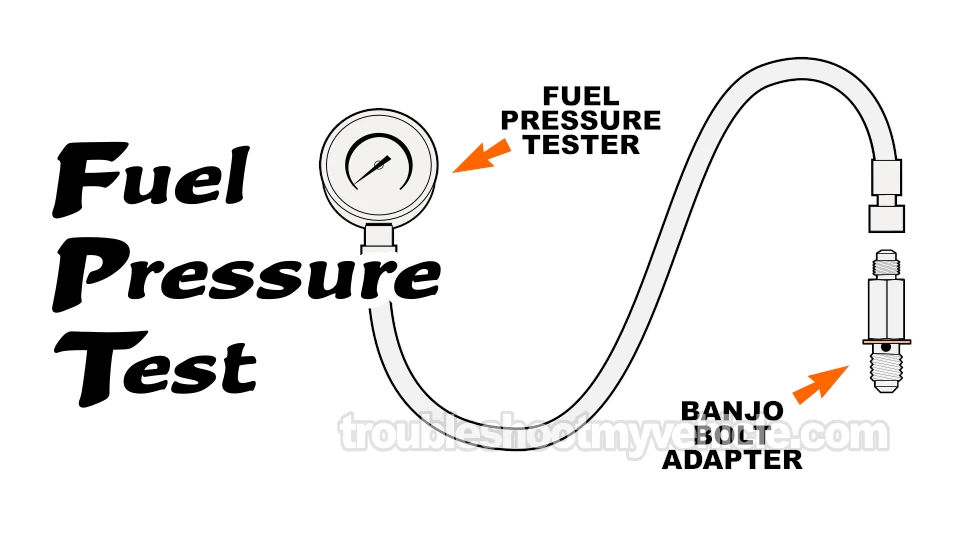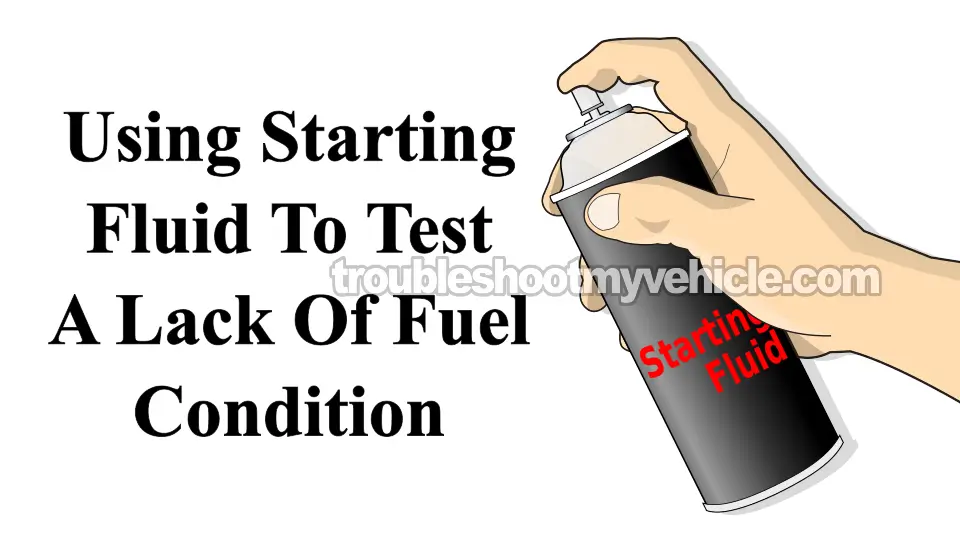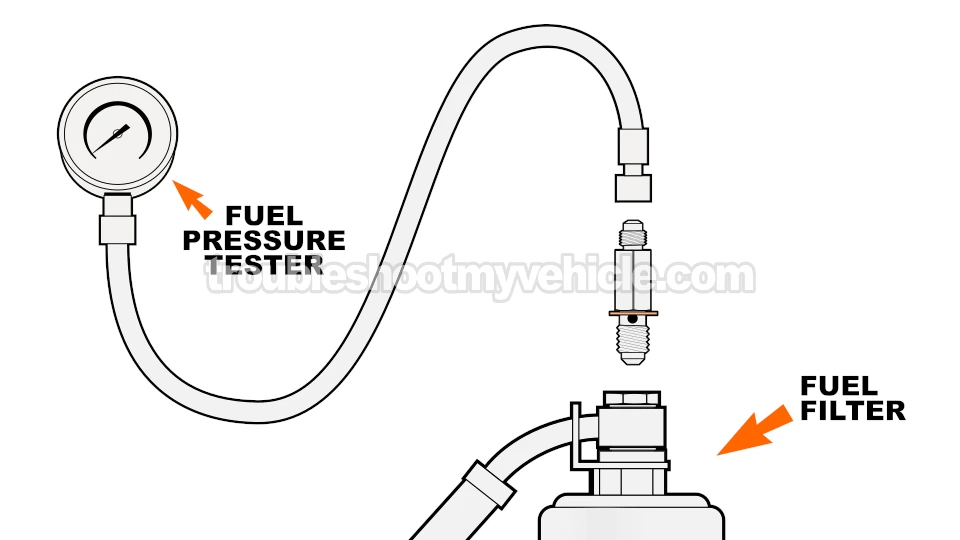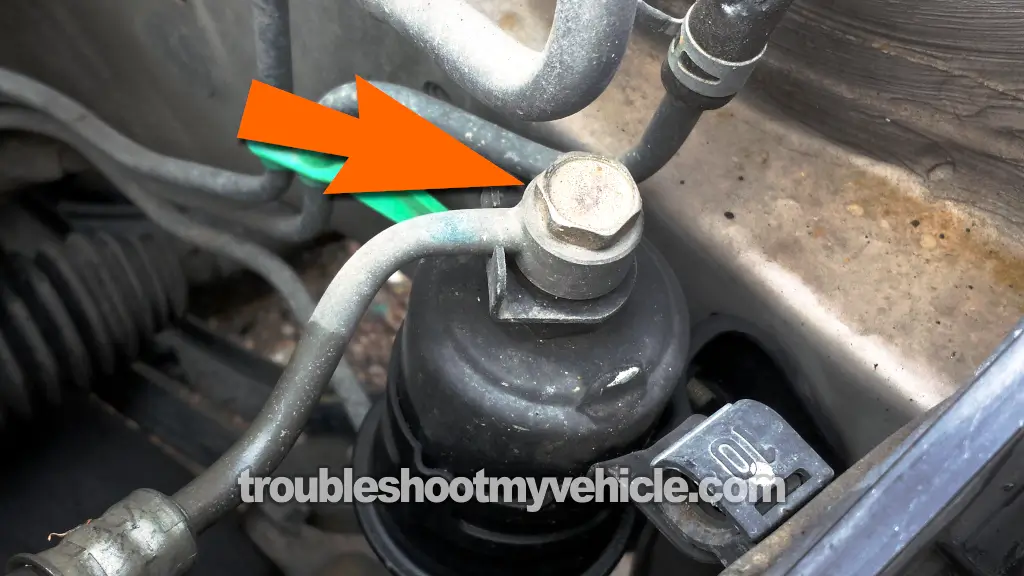
You can test the fuel pump on your 1997 3.0L V6 Toyota Camry with a fuel pressure test gauge - it's a whole lot easier than you might think.
If your Camry won't start or is running rough, and you think the fuel pump might be the culprit, a fuel pressure test gauge is your best bet for figuring out what's wrong.
In this tutorial, I'll walk you through how to connect the fuel pressure test gauge, what numbers to look for, and a quick trick using starting fluid to confirm whether a lack of fuel pressure is really causing the no-start problem.
Contents of this tutorial:
- Symptoms Of A Bad Fuel Pump.
- Where To Buy A Fuel Pressure Test Gauge.
- TEST 1: Checking Fuel Pressure With A Fuel Pressure Gauge (With Scan Tool).
- TEST 2: Checking Fuel Pressure With A Fuel Pressure Gauge (Without Scan Tool).
- TEST 3: Using Starting Fluid To Confirm Lack Of Fuel.
- More 3.0L V6 Toyota Camry Tutorials.
APPLIES TO: This tutorial applies to the following vehicles:
- 3.0L V6 Toyota Camry: 1997.
Fuel Pump Circuit Wiring Diagrams:
Toyota Fuel Pump Test Tutorials:
- How To Test The Fuel Pump (1992-1993 3.0L V6 Toyota Camry).
- How To Test The Fuel Pump (1994-1996 3.0L V6 Toyota Camry).
- How To Test The Fuel Pump (1998-2001 3.0L V6 Toyota Camry).
Engine No-Start Diagnostics:
Symptoms Of A Bad Fuel Pump
Typically, fuel pumps meet their demise in one of two scenarios:
- The fuel pump suddenly stops working: In this case, your Camry's engine doesn't start anymore.
- The fuel pump starts to fail gradually: The engine still starts, but performance issues will pop up - especially when the engine is under load.
You'll know something's amiss with your 3.0L V6 Toyota Camry when:
- You turn the key, but the engine won't start, even though it turns over.
- An ignition system spark test shows all cylinders are getting spark, so the ignition system isn't the problem.
- A Noid light test confirms that your Camry's fuel injection computer is enabling (activating) the fuel injectors.
- Your fuel pressure test gauge reads zero - that's a dead giveaway that the fuel pump is shot.
- If you spray some starting fluid into the throttle body and crank the engine, it'll start and run for a few seconds.
If your fuel pump is on the fritz (where it's still sending just enough fuel to start the engine), you'll likely see one or more of these symptoms:
- Your Camry's fuel injection computer throws up lean air/fuel mixture trouble codes.
- The engine has a rough idle.
- The engine takes forever to start (extended engine cranking).
- When you hit the gas, the engine feels underpowered.
- You hear backfires popping through the intake manifold when you're pushing the engine hard.
A fuel pressure test to determine if the fuel pump is behind the engine no-start issue or engine performance problem is a game-changer when it comes to avoiding replacing parts that won't solve the problem.
Where To Buy A Fuel Pressure Test Gauge
A fuel pressure test gauge is a must have tool to DIY like a pro. You can grab one at most auto parts stores or online.
The following inexpensive fuel pressure test gauge kits come with adapters that'll help you troubleshoot your 3.0L V6 Toyota Camry (and they've got GM and Ford owners with fuel system's equipped with Schrader valves covered too).
Disclosure: As an Amazon Associate, I earn from qualifying purchases. If my tutorials help you, using these links is an easy way to support the site at no extra cost to you. Thank you!
NOTE: All of the fuel pump pressure test kits above have the fitting that will connect to your Toyota's fuel system.
TEST 1: Checking Fuel Pressure With A Fuel Pressure Gauge (With Scan Tool)
If you have a scan tool that has "active test" capability, where you can activate the fuel pump with the scan tool (key on engine off), then this is the section for you (if you don't go to TEST 3).
What we're gonna is connect a fuel pressure test gauge to the fuel filter's output side with a special adapter.
Once connected, we'll activate the fuel pump via the scan tool and check the fuel pressure reading with the specification:
| Key On Engine Off (fuel pump activated by scan tool). |
|---|
| 44-50 PSI |
NOTE: If you don't have a fuel pressure gauge, take a look at the section: Where To Buy A Fuel Pressure Test Gauge.
OK, let's begin:
- 1
Remove the top part of the air filter assembly to access the fuel filter.
- 2
Wrap a shop towel around the fuel filter union bolt (see photo 3 of 3 above).
This shop towel will absorb and keep any fuel from dripping/leaking/spraying on the engine (if there's any residual fuel pressure in the fuel line) as you loosen the bolt. - 3
Remove the fuel filter's union bolt.
NOTE: Careful the union bolt's 2 copper washers don't fall and get lost in the engine compartment. You'll need to re-install them when you get done with the fuel pressure test. - 4
Install the fuel pressure test kit's adapter in place of the union bolt and tighten it (the adapter).
- 5
Turn the key ON and OFF several times (but don't crank or start the engine) to activate the fuel pump and check for fuel leaks around the fuel gauge adapter.
NOTE: Check the fuel pressure gauge's adapter connection for fuel leaks. If any leaks are present, turn the key OFF and resolve them to get an accurate fuel pressure output result. - 6
Turn the key to the ON position but don't crank or start the engine.
- 7
Connect the scan tool and go to its "Active Tests" section.
- 8
Activate the fuel pump via the scan tool.
- 9
Your fuel pressure gauge should register: 44-50 PSI.
Let's take a look at what your results mean:
CASE 1: The fuel pressure gauge registered 0 PSI. This confirms that the cause of your 3.0L V6 Toyota Camry no-start problem is caused by the fuel pump not sending any fuel to the fuel injectors.
CASE 2: The fuel pressure gauge registered the specified fuel pressure. This test result lets you know that the fuel pump is working and delivering enough fuel to the fuel injectors.
The reason your 3.0L V6 Toyota Camry is not starting is due to another reason. The fuel pump is OK. The following tutorial will help you further diagnose the issue:
CASE 3: The fuel pressure gauge registered a lower pressure than the specified fuel pressure (but not 0 PSI). This test result lets you know that the fuel pump is weak and failing.
While it's still delivering some fuel, it's not enough to meet the engine's requirements for starting or running properly. The fuel pump needs to be replaced.
TEST 2: Checking Fuel Pressure With A Fuel Pressure Gauge (Without Scan Tool)
The fuel pump can be tested without a scan tool and in this section, I'll explain how.
OK, to check the fuel pump's pressure output, we'll connect a fuel pressure test gauge to the fuel filter's output side with a special adapter.
I'm gonna explain the whole test set-up procedure step-by-step in the instructions below.
| Engine running or engine cranking |
|---|
| 44-50 PSI |
NOTE: If you don't have a fuel pressure gauge, take a look at the section: Where To Buy A Fuel Pressure Test Gauge.
OK, let's begin:
- 1
Remove the top part of the air filter assembly to access the fuel filter.
- 2
Wrap a shop towel around the fuel filter union bolt (see photo 3 of 3 above).
This shop towel will absorb and keep any fuel from dripping/leaking/spraying on the engine (if there's any residual fuel pressure in the fuel line) as you loosen the bolt. - 3
Remove the fuel filter's union bolt.
NOTE: Careful the union bolt's 2 copper washers don't fall and get lost in the engine compartment. You'll need to re-install them when you get done with the fuel pressure test. - 4
Install the fuel pressure test kit's adapter in place of the union bolt and tighten it (the adapter).
- 5
Turn the key ON and OFF several times (but don't crank or start the engine) to activate the fuel pump and check for fuel leaks around the fuel gauge adapter.
NOTE: Check the fuel pressure gauge's adapter connection for fuel leaks. If any leaks are present, turn the key OFF and resolve them to get an accurate fuel pressure output result. - 6
Crank and start the engine.
NOTE: If the engine doesn't start, no worries. Crank the engine long enough to get a fuel pressure reading on the gauge. - 7
Your fuel pressure gauge should register:
Engine running: 44-50 PSI.
Engine cranking (engine does not start): 44-50 PSI.
Let's take a look at what your results mean:
CASE 1: The fuel pressure gauge registered 0 PSI. This confirms that the cause of your 3.0L V6 Toyota Camry no-start problem is caused by the fuel pump not sending any fuel to the fuel injectors.
CASE 2: The fuel pressure gauge registered the specified fuel pressure. This test result lets you know that the fuel pump is working and delivering enough fuel to the fuel injectors.
The reason your 3.0L V6 Toyota Camry is not starting is due to another reason. The fuel pump is OK. The following tutorial will help your troubleshoot the no-start problem:
CASE 3: The fuel pressure gauge registered a lower pressure than the specified fuel pressure (but not 0 PSI). This test result lets you know that the fuel pump is weak and failing.
While it's still delivering some fuel, it's not enough to meet the engine's requirements for starting or running properly. The fuel pump needs to be replaced.
TEST 3: Using Starting Fluid To Confirm Lack Of Fuel

A classic diagnostic test that helps troubleshoot an engine no-start is spraying starting fluid into the throttle body and (then) cranking the engine.
In a nutshell, if the engine no-start problem is with your Camry's fuel system, the starting fluid will get the engine running for a few seconds.
I've used this method plenty of times, and it has always pointed me in the right direction in knowing whether a lack of fuel is behind the engine no-start problem.
Before you perform the test, make sure all six cylinders are getting spark. It's important that you use a spark tester to get an accurate test result.
IMPORTANT: When you're done spraying starting fluid into the throttle body, don't forget to put the air intake duct back on (you don't need to tighten the air duct hose clamp). This way, if there's any backfiring while cranking the engine, it won't exit out of the throttle body.
This is what you have to do:
- 1
Remove the intake air duct from the throttle body. You don't have to completely remove it, since you'll have to reconnect it in one of the next steps.
- 2
Open the throttle plate and spray starting fluid down the bore.
As a safety precaution reconnect the air duct after you have sprayed a good squirt of starting fluid (but you don't have to tighten the air duct's hose clamp). - 3
Crank the engine once the air duct is back on and you're clear of the engine compartment.
- 4
You'll see one of two things:
1.) The engine starts and runs for a few seconds.
2.) The engine doesn't start.
OK, let's find out what your results mean:
CASE 1: The engine started and ran for a few seconds. This test result tells you that the no-start problem is due to a lack of fuel.
Your next step is to check to see what the fuel pressure is with a fuel pressure test gauge. Go to: TEST 1: Checking Fuel Pressure With A Fuel Pressure Gauge.
CASE 2: The engine did not start, not even momentarily. This usually means that a lack of fuel IS NOT the reason your car is not starting.
Now, remember what I said about this test not being very accurate? Well, I suggest you do one more test and this is to check the fuel pressure with a fuel pressure test gauge. Go to: TEST 1: Checking Fuel Pressure With A Fuel Pressure Gauge.
More 3.0L V6 Toyota Camry Tutorials
You can find a complete list of 3.0L V6 Toyota Camry tutorials and wiring diagrams in this index:
Here's a sample of the tutorials you'll find there:
- How To Test Engine Compression (1992-2006 3.0L V6 Toyota Camry).
- How To Test For A Blown Head Gasket (1992-2006 3.0L V6 Toyota Camry).
- How To Test The Ignition Coils (1996-2001 3.0L V6 Toyota Camry).
- How To Test The Crankshaft Position (CKP) Sensor (1994-2006 3.0L V6 Toyota Camry.

If this info saved the day, buy me a beer!






